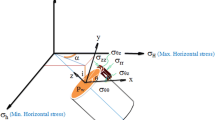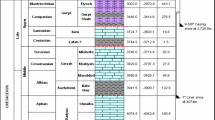Abstract
During the drilling process, wellbore instability leads to a complex wellbore morphology. Thus, serious drilling accidents, such as leakage and sticking, can occur. Therefore, it is important to choose different failure criteria for different geological engineering conditions to calculate the safe density window of the drilling fluid to prevent borehole wall instability. In this study, the applicability of three different rock failure criteria, Mohr–Coulomb, Mogi–Coulomb, and Drucker–Prager, was examined under five different fault mechanisms, and the variation in borehole collapse pressure with the trajectory of the borehole under different fault mechanisms was investigated. The results provided a scientific basis for the selection of failure criteria under different geological engineering conditions. The relevant theory provides a reference for well trajectory design, well location selection, and drilling directions.
Article highlights
-
The paper analyzes the change trend of the collapse pressure of the well wall with the azimuth angle of the well slope under different failure criteria. Then compared with the actual drilling fluid density on site to obtain the optimal results of failure criteria under different fault mechanisms. The results can optimize the failure criteria for different stratum conditions in the subsequent collapse of the wellbore
-
The best drilling direction can be obtained by analyzing the results of the stability calculation of the wellbore trajectory under five fault mechanisms
-
The conclusion provides a more specific scientific basis for the selection of failure criteria and the calculation of drilling fluid safety density window under different formation conditions in actual drilling

















Similar content being viewed by others
References
Al-Ajmi AM, Zimmerman RW (2006) Stability analysis of vertical boreholes using the Mogi-Coulomb failure criterion. Int J Rock Mech Min Sci 43(8):1200–1211
Bezalel C, Haimson et al (2002) True triaxial strength of the KTB amphibolite under borehole wall conditions and its use to estimate the maximum horizontal in situ stress. J Geophys Res: Solid Earth 107(B10):ETG 15-1-ETG 15-14
Deng J, Zhang H (1998) Mechanical mechanism of wellbore instability during drilling. Petroleum Industry Press, Beijing
Deng H, Meng M, Chen L et al (2006) Study on stability of brittle shale hydration. Nat Gas Ind 26(2):73–76
Feng Y, Deng J, Li X et al (2012) Criteria for wellbore stability evaluation. Fault Block Oil Gas Field 19(2):244–248
Haimson BC, Chang C (2000) A new true triaxial cell for testing mechanical properties of rock, and its use to determine rock strength and deformability of Westerly granite. Int J Rock Mech Miningences 37(1):285–296
He M, Lu X, Jing H (2002) Characters of surrounding rock mass in deep engineering and its non-linear dynamical design concept. Chin J Rock Mech Eng 12(8):1215–1224
Islam MA, Skalle P, Al-Ajmi AM, et al (2010) Stability analysis in shale through deviated boreholes using the Mohr and Mogi-Coulomb failure criteria. In: 44th US Rock Mechanics Symposium and 5th U.S.-Canada Rock Mechanics Symposium, held in Salt Lake City, UT
Li Y, Weijermars R (2019) Wellbore stability analysis in transverse isotropic shales with anisotropic failure criteria. J Petrol Sci Eng 176:982–993
Liu W, Qian X, Li T et al (2018) Investigation of the tool-rock interaction using Drucker Prager failure criterion. J Pet Sci Eng 173:269–278
Ma T, Yang Z, Chen P et al (2017) Collapse risk for deviated borehole in shale formations based on true-triaxial strength criterion. J Southwest Pet Univ 39(1):161–168
Mclean MR, Addis MA (1990) Wellbore stability analysis: a review of current methods of analysis and their field application. Soc Pet Eng
Santarelli FJ (1987) Theoretical and experimental investigation of the stability of the axisymmetric wellbore. Imperial College, London
Takahashi M, Koide H (1989) Effect of the intermediate principal stress on strength and deformation behavior of sedimentary rocks at the depth shallower than 2000 M. In: International Symposium on Rock at Great Depth
Wang J, Li G, Zhao H et al (2012) Stability analysis of a borehole wall during horizontal directional drilling in fluid-solid coupling condition. Chin J Undergr Space Eng 8(4):796–801
Wang T, Zhang T, Ranjith PG et al (2019) A new approach to the evaluation of rock mass rupture and brittleness under triaxial stress condition. J Pet Sci Eng 184:106482
Yang Z, Li J, Su C et al (2008) Advances in side wall strengthening technology. Fault-Block Oil Gas Field 15(3):99–102
Zhao W, Ge J, Wang T et al (2020) Study on catastrophe mechanism of hydraulic fracturing fracks initiation in radial boreholes. Geomech Geophys Geo-Energy Geo-Resour. https://doi.org/10.1007/s40948-020-00169-7
Zhao W, Liu Y, Wang T et al (2021) Stability analysis of wellbore for multiple weakness planes in shale formations. Geomech Geophys Geo-Energy Geo-Resour. https://doi.org/10.1007/s40948-021-00228-7
Acknowledgements
This research was supported by the National Natural Science Foundation of China (Grant Nos. 52074088, 51574088, and 51404073), Talented Reserves of Heilongjiang Province Science Foundation for Distinguished Young Scholars of Northeast Petroleum University (Grant No. SJQHB201802), Development of Western Oil Fields Special Project (Grant No. XBYTKT202001), Talented Reserves of Heilongjiang Province Science Foundation for Distinguished Young Scholars of Northeast Petroleum University (Grant No. SJQH202002), and the project of Heilongjiang Province in 2020 (Research on locally induced fracture evolution mechanism of energy storage fracturing in shale reservoirs).
Author information
Authors and Affiliations
Corresponding author
Ethics declarations
Conflict of interest
To the best of our knowledge, the authors have no conflicts of interest, financial, or otherwise.
Additional information
Publisher's Note
Springer Nature remains neutral with regard to jurisdictional claims in published maps and institutional affiliations.
Rights and permissions
About this article
Cite this article
Wang, T., Liu, Y., Cai, M. et al. Optimization of rock failure criteria under different fault mechanisms and borehole trajectories. Geomech. Geophys. Geo-energ. Geo-resour. 8, 127 (2022). https://doi.org/10.1007/s40948-022-00430-1
Received:
Accepted:
Published:
DOI: https://doi.org/10.1007/s40948-022-00430-1




